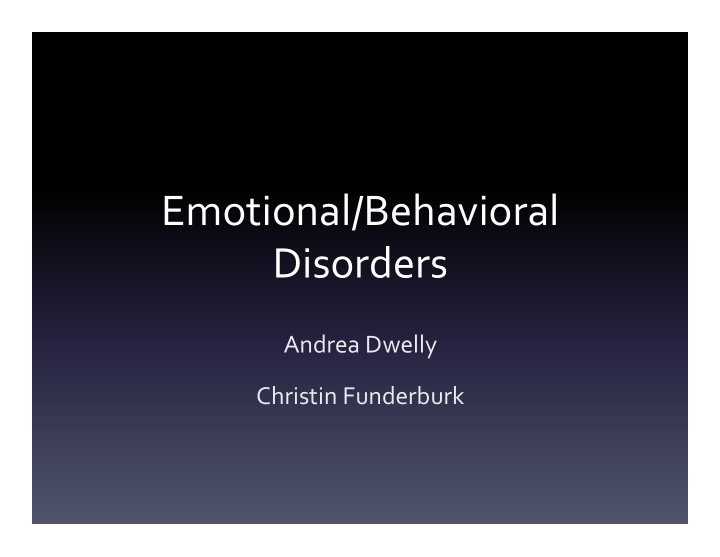



Emotional/Behavioral ¡ Disorders ¡ Andrea ¡Dwelly ¡ Christin ¡Funderburk ¡
IDEA ¡Definition ¡ “A ¡condition ¡exhibiting ¡one ¡or ¡more ¡of ¡the ¡following ¡ characteristics ¡over ¡a ¡long ¡period ¡of ¡time ¡and ¡to ¡a ¡ marked ¡degree, ¡which ¡adversely ¡affects ¡educational ¡ performance: ¡ v An ¡inability ¡to ¡learn ¡which ¡cannot ¡be ¡explained ¡by ¡intellectual, ¡sensory, ¡or ¡ health ¡factors. ¡ v An ¡inability ¡to ¡build ¡or ¡maintain ¡satisfactory ¡interpersonal ¡relationships ¡ with ¡peers ¡and ¡teachers. ¡ v Inappropriate ¡types ¡of ¡behavior ¡or ¡feelings ¡under ¡normal ¡circumstances. ¡ v A ¡general ¡pervasive ¡mood ¡of ¡unhappiness ¡or ¡depression. ¡ v A ¡tendency ¡to ¡develop ¡physical ¡symptoms ¡or ¡fears ¡associated ¡with ¡ personal ¡or ¡school ¡problems. ¡ v Includes ¡Schizophrenia ¡(etc.), ¡Excludes ¡Socially ¡Maladjusted ¡Students ¡
Basic ¡Info ¡ v Behavior ¡Excess ¡or ¡Deficits ¡ v “Behavior ¡Disorders” ¡vs. ¡ ¡ ¡ ¡ ¡ ¡ ¡ ¡ ¡ ¡ ¡ ¡ ¡ ¡ ¡ ¡ ¡ ¡ ¡ ¡ ¡ ¡ “Emotional ¡Disturbances” ¡
Patterns ¡and ¡Types ¡ v Externalizers ¡ ¡ v Internalizers ¡ v ¡Conduct ¡Disorders ¡ v Personality ¡Disorders ¡ v Immaturity ¡ v Socialized ¡Delinquency ¡ v Characteristics ¡
Deafness ¡& ¡EBD ¡ ² Research ¡Based ¡(1985) ¡ ² High ¡Percentage ¡ ¡ ² No ¡standard ¡diagnosis ¡method ¡
Goals ¡ • Master ¡academics ¡ • Develop ¡social ¡skills ¡ • Increase ¡students’: ¡ – self-‑awareness ¡ – self-‑control ¡ – self-‑esteem ¡
Strategies ¡Overview ¡ • Student ¡Engagement ¡ • Student ¡Motivation ¡ • Recognize ¡and ¡Encourage ¡ • Classroom ¡Management ¡ ¡
Student ¡Engagement ¡ • Keep ¡objectives ¡clear ¡ • Use ¡meaningful ¡materials ¡ • Break ¡presentations ¡into ¡shorter ¡segments ¡ • Extend ¡the ¡time ¡to ¡complete ¡tasks ¡ • Cooperative ¡learning ¡
Student ¡Motivation ¡ • Build ¡upon ¡students ¡interests ¡ • Allow ¡students ¡to ¡make ¡choices ¡ • Vary ¡activities ¡ • Use ¡hands-‑on ¡learning ¡activities ¡
Classroom ¡Management ¡ • Provide ¡structured ¡environment ¡ • Consistent ¡rules ¡and ¡expectations ¡ • Establish ¡routines ¡and ¡procedures ¡ • Maintain ¡a ¡positive ¡classroom ¡climate ¡ • Some ¡Techniques: ¡ – Positive ¡reinforcement ¡ – Time-‑out/ ¡Cool ¡down ¡zone ¡ – Create ¡a ¡silent ¡signal ¡
Recognize ¡and ¡Encourage ¡ • Reward ¡Frequently ¡ • Bonus ¡Points ¡(specific ¡task ¡and ¡timeframe) ¡ • Accomplishment ¡Sheets ¡ • Personal ¡Notes ¡of ¡Encouragement ¡
Challenges ¡ • Communicating ¡verbally ¡or ¡in ¡writing ¡ • Interacting ¡appropriately ¡in ¡class ¡ • Difficulty ¡staying ¡on ¡task ¡ ¡
References ¡ American ¡Institutes ¡for ¡Research, ¡ Educational ¡Strategies ¡for ¡Children ¡with ¡Emotional ¡ • and ¡Behavioral ¡Problems, ¡http://cecp.air.org/aft_nea.pdf ¡ Council ¡for ¡Exceptional ¡Children, ¡ Behavior ¡Disorders/Emotional ¡Disturbances, ¡ http:// • www.cec.sped.org/AM/Template.cfm? Section=Behavior_Disorders_Emotional_Disturbance ¡ Gallaudet ¡University ¡– ¡Laurent ¡Clerc ¡National ¡Deaf ¡Education ¡Center, ¡ Emotional/ • Behavior ¡Disorders, ¡ ¡ National ¡Dissemination ¡Center ¡for ¡Children ¡with ¡Disabilities, ¡ Disabilities:Emotional ¡ • Disturbance , ¡http://nichcy.org/disability/specific/emotionaldisturbance ¡ Pearson ¡Allyn ¡Bacon ¡Prentice ¡Hall, ¡ Emotional ¡and ¡Behavioral ¡Disorders, ¡http:// • www.education.com/reference/article/emotional-‑behavioral-‑disorders-‑prevention/? page=3 ¡
Recommend
More recommend